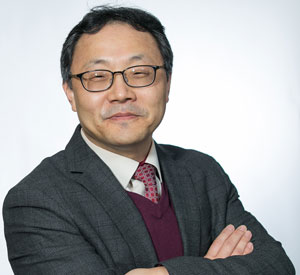Behind the research: Jae-Hyuck Shim strives to unlock cure for devastating childhood bone disease
For UMass Medical School researcher Jae-Hyuck Shim, PhD, seeing the strength of families who have a child with a rare, crippling disease motivates him to develop a gene therapy that will help afflicted children retain mobility and be free from debilitating pain. He is also spurred by his own experience as a child, when he was diagnosed with juvenile rheumatoid arthritis.

Fibrodysplasia ossificans progressiva (FOP) occurs at an incidence of one per 1.36 million to 2 million people, according to Dr. Shim, associate professor of medicine in the Division of Rheumatology and a member of the Horae Gene Therapy Center. This disease is characterized by abnormal bone formation in the skeletal muscle and in connective tissues. When there is any trauma to a muscle or other connective tissue, the resulting inflammation causes bone to form—like an extra skeleton—that progressively locks up joints and causes immobility and severe pain.
“It’s heartbreaking. You have no idea when you’re born whether you have FOP or not,” said Shim. “Then when a kid is little, he’s playing soccer or tumbles, and the inflammation doesn’t go away. Then three weeks later, somehow bone starts coming up; then two months later, you start to lock up your joints. And that’s just the beginning.”
Shim said, “To me, the most devastating is the parents, because the parents see their kid get worse slowly and progressively.”
No effective treatments are available except for high doses of corticosteroids for flare-ups, which can reduce the intense pain and edema, but nothing stops the extra-skeletal bone growth.
Almost 90 percent of patients die by age 40, Shim said.
FOP is a monogenic skeletal rare disease caused by autosomal dominant mutations in the Activin A type 1 receptor, Shim explained, which results in spontaneous activation of bone morphogenic protein signaling pathways and other changes.
Two years ago, Shim’s lab teamed up with the laboratories of Guangping Gao, PhD, the Penelope Booth Rockwell Professor in Biomedical Research, professor of microbiology & physiological systems, director of the Horae Gene Therapy Center and co-director of the Li Weibo Institute for Rare Diseases Research, and Jun Xie, PhD, associate professor of microbiology & physiological systems, to develop adeno-associated virus (AAV)-mediated gene therapy for FOP.
This research has been supported by the nonprofit International FOP Association (IFOPA) and the startup company AAVAA Therapeutics co-founded by Shim and Dr. Gao. A production crew from IFOPA was recently on the UMass Medical School campus to create a video to support continuing research on FOP.
Shim knows personally how hard it can be for children and their families when a child suddenly develops a life-altering disease.
“When I was a kid, just out of high school, I had juvenile rheumatoid arthritis,” said Shim. “One day I just woke up, I couldn’t walk well because it hurt. Most of juvenile rheumatoid arthritis is inherited. My mother doesn’t show any rheumatic disease, but she sometimes feels tired.”
He continued, “I have three sisters, but I’m the only son and my family was upside down. My mother was really feeling guilty because she thought it was from her. And my father was upset because he wanted to know what happened.”
Twenty years ago in Korea, where Shim grew up, less was known about the role of inflammation, he said. “I went to the hospital orthopedic department many times and they just gave me painkillers. For one year, living my life was totally disastrous. I was very sad because I saw my mother cry.”
But then one of Shim’s doctors, who had studied in the United States, brought Shim into his clinic and gave him anti-inflammatory drugs. “It’s kind of a miracle,” said Shim. “He killed the inflammation, and everything went away.”
The doctor told Shim he could continue to take medication or change his body through lifestyle to keep his auto-immune condition under control.
“So, I changed my eating habits and exercise and sleeping, and the chronic inflammation went down,” Shim said. “The doctor said I didn’t need the medicine anymore because my body was actually changed.”
Shim hopes that children with FOP can get to experience something similar. “If the medicine is there to bring down the flareup, pulling it down to the normal level that is under the threshold, then they can manage it,” he said. They could potentially then have surgery to remove the extra-skeleton, which currently would only cause further inflammation and bone growth from trauma to the musculoskeletal system.
The gene therapy that UMass Medical School-affiliated researchers are developing is the only project of its kind for FOP, delivering the therapeutic gene directly to the FOP-causing cell or tissue using the AAV, according to Shim. Using the combinatory expression of a mutant-specific gene silencer and healthy gene, the AAV removes the mutant protein and at the same time, the healthy protein can be expressed. They have had success in human FOP patient-derived cells and animal models.
That progress, in humans, is something families of children with FOP are desperate to reach. Shim saw at IFOPA meetings how strong the community of families was, sharing information and support, and he wants to do all he can to help them.
“Many parents feel uncomfortable at first, but in IFOPA they start to share,” said Shim. “It’s a very devastating disease and we need the funding to stop it.”